Spatio-Temporal Evolution Characteristics and Influencing Factors of Urban Service-Industry Land in China
Abstract
:1. Introduction
2. Literature Review
2.1. Abundance of Relevant Research Results, but Lack of Specialized Papers
2.2. Research on Influencing Factors Is on the Increase, but Lacks Systematicness and Comprehensiveness
3. Research Design
3.1. Study Area: China
3.2. Research Methods
3.2.1. Decoupling Model
3.2.2. GeoDetector
3.2.3. Spatial Cold- and Hot-Spot Analysis
3.3. Index Selection
3.4. Research Steps
3.5. Data Sources
4. Results
4.1. Dynamic Characteristic Analysis
4.1.1. Land Area
4.1.2. Per Area Added Value
4.1.3. Per Unit Area Investment
4.2. Decoupling-Type Analysis
4.2.1. Added Value of Service-Industry
4.2.2. Gross Domestic Product
4.3. Driving Mechanism Analysis
4.3.1. Influence Factors Analysis
4.3.2. Interaction-Detector Analysis
5. Discussion
5.1. Theoretical Value
5.2. Policy Enlightenment
6. Conclusions
- (1)
- The scale, output efficiencies and development intensities of service-land in China are increasing, with significant inter-provincial differences and levels of agglomeration. From the perspective of time series analysis, trends in the change of service-land includes regions with trends in forms of a “J”, “U”, and “inverted U”, alongside stable regions, and the development trend is increasingly differentiated. From the perspective of spatial cluster analysis, with 0.2 as the step distance, the 31 provinces are divided into 5 categories of higher-, high-, mean-, low- and lower-levels according to the share of service-land. The service-land scale was always dominated by the low-level, and the output efficiency and development intensity of service-land have been gradually transformed from being low- and lower-level oriented to high- and higher-level oriented. In addition, the spatial pattern of service-land scale, output efficiency and development intensity are changing greatly, and the 5 types of regions have prominent levels of spatial agglomeration and regularity characteristics. From the cluster analysis of cold- and hot-spots, the spatial pattern of service-land scale is stable, with a gradual change from east to middle to west; the service-land output efficiencies and development intensities have prominent spatial agglomeration characteristics, but the agglomeration areas of cold- and hot-spots change greatly in different periods.
- (2)
- Among Tapio’s 8 types of decoupling, 5 are shown in the results of our analysis that used the decoupling model of service-land and economic development for 2012–2020, these included strong decoupling, weak decoupling, expansive coupling, expansive negative decoupling, and strong negative decoupling. Most provinces and cities are in a state of weak decoupling, with only a few in the best state (strong decoupling), and some in the worst state of strong negative decoupling. This indicates that the development of China’s service-industry still depends on the input of land-resources, and that promoting early decoupling between the two is an important task for achieving high-quality development.
- (3)
- There are many factors driving the changes in service-land, and the relationship between factors is becoming more complicated and diversified. Urban construction-land area, added value of secondary industry, urban industry-land area, number of enterprises with e-business transactions, total retail sales of social consumer goods are critical factors, and their direct forcing is prominent. Gross domestic product, total retail sales of social consumer goods and number of people over 65 are important factors, and they are driven synergistically by direct and indirect forces. Number of people over 65, resident population, foreign direct investment, per capita disposable income of residents, and number of mobile internet users are super-interaction factors, and they mainly exert their influence by indirect forces. The direct and indirect forces of factors such as population urbanization rate and per capita consumption expansion of residents are weak, and they mainly play an auxiliary driving role.
Author Contributions
Funding
Institutional Review Board Statement
Informed Consent Statement
Data Availability Statement
Conflicts of Interest
Appendix A
| 0.1396 ※ | ||||||||||||||||||||
| 0.8973 | 0.6721 | |||||||||||||||||||
| 0.3339 | 0.9727 | 0.3073 | ||||||||||||||||||
| 0.3048 | 0.9222 ※ | 0.3609 | 0.1612 | |||||||||||||||||
| 0.9092 | 0.9900 | 0.9224 | 0.9054 | 0.8802 | ||||||||||||||||
| 0.8645 | 0.9801 | 0.8589 | 0.8556 | 0.9872 | 0.8292 | |||||||||||||||
| 0.8995 | 0.9939 | 0.9073 | 0.8941 | 0.9046 | 0.9816 | 0.8714 | ||||||||||||||
| 0.3044 | 0.9811 | 0.3504 | 0.3070 | 0.9256 | 0.8626 | 0.9180 | 0.2812 | |||||||||||||
| 0.8622 | 0.9801 | 0.8611 | 0.8563 | 0.9894 | 0.8849 | 0.9792 | 0.8775 | 0.8399 | ||||||||||||
| 0.8582 | 0.9899 | 0.8516 | 0.8512 | 0.9875 | 0.8922 | 0.9809 | 0.8727 | 0.8699 | 0.8420 | |||||||||||
| 0.8113 | 0.9857 | 0.8121 | 0.8021 | 0.9941 | 0.8940 | 0.9846 | 0.8302 | 0.8730 | 0.8667 | 0.7860 | ||||||||||
| 0.7495 | 0.9912 | 0.7787 | 0.7516 | 0.9321 | 0.8820 | 0.9290 | 0.7868 | 0.8927 | 0.8941 | 0.8984 | 0.7310 | |||||||||
| 0.7515 | 0.9831 | 0.7716 | 0.7741 | 0.9257 | 0.8538 | 0.9304 | 0.7753 | 0.8922 | 0.8783 | 0.8776 | 0.8577 | 0.7314 | ||||||||
| 0.8693 | 0.9903 | 0.8976 | 0.8674 | 0.9177 | 0.9883 | 0.9253 | 0.8858 | 0.9804 | 0.9818 | 0.9930 | 0.9365 | 0.9354 | 0.8532 | |||||||
| 0.9182 | 0.9827 | 0.9085 | 0.9206 | 0.9344 | 0.9617 | 0.9381 | 0.9312 | 0.9887 | 0.9957 | 0.9964 | 0.9346 | 0.9146 | 0.9365 | 0.8788 | ||||||
| 0.8927 | 0.9943 | 0.9126 | 0.8974 | 0.9195 | 0.9787 | 0.9114 | 0.9289 | 0.9954 | 0.9905 | 0.9950 | 0.9229 | 0.9265 | 0.9228 | 0.9334 | 0.8681 | |||||
| 0.8510 | 0.9855 | 0.8558 | 0.8630 | 0.9338 | 0.9850 | 0.9184 | 0.8586 | 0.9966 | 0.9777 | 0.9748 | 0.9315 | 0.8852 | 0.9245 | 0.9353 | 0.9267 | 0.8311 | ||||
| 0.8621 | 0.9954 | 0.8567 | 0.8550 | 0.9295 | 0.9796 | 0.9382 | 0.8579 | 0.9901 | 0.9742 | 0.9943 | 0.9346 | 0.8914 | 0.9111 | 0.9377 | 0.9384 | 0.8840 | 0.8462 | |||
| 0.8626 | 0.9686 | 0.8687 | 0.8720 | 0.9372 | 0.9877 | 0.9382 | 0.8750 | 0.9893 | 0.9946 | 0.9804 | 0.9407 | 0.8995 | 0.9169 | 0.9379 | 0.9287 | 0.9002 | 0.8763 | 0.8542 | ||
| 0.9166 | 0.8053 | 0.9537 | 0.9213 | 0.9856 | 0.9861 | 0.9905 | 0.9447 | 0.9821 | 0.9831 | 0.9772 | 0.9994 | 0.9829 | 0.9702 | 0.9903 | 0.9895 | 0.9892 | 0.9879 | 0.9870 | 0.7680 |
| 0.3314 | ||||||||||||||||||||
| 0.9605 | 0.7014 | |||||||||||||||||||
| 0.3981 | 0.9448 | 0.2930 | ||||||||||||||||||
| 0.3784 | 0.9612 | 0.3206 | 0.2852 | |||||||||||||||||
| 0.9359 | 0.9844 | 0.9389 | 0.9316 | 0.8704 | ||||||||||||||||
| 0.4743 | 0.9633 | 0.3319 | 0.3944 | 0.9250 | 0.2343 | |||||||||||||||
| 0.9066 | 0.9915 | 0.8801 | 0.8752 | 0.9959 | 0.9419 | 0.8686 | ||||||||||||||
| 0.8201 | 0.9932 | 0.8059 | 0.8093 | 0.9119 | 0.8200 | 0.9819 | 0.7450 | |||||||||||||
| 0.7148 | 0.9629 | 0.6541 | 0.6744 | 0.9241 | 0.6708 | 0.9610 | 0.7903 | 0.6146 | ||||||||||||
| 0.8320 | 0.9918 | 0.7994 | 0.8048 | 0.9529 | 0.8135 | 0.9697 | 0.9365 | 0.7722 | 0.7302 | |||||||||||
| 0.7890 | 0.9868 | 0.7484 | 0.7455 | 0.9951 | 0.7951 | 0.9959 | 0.9646 | 0.8106 | 0.7850 | 0.6941 | ||||||||||
| 0.9745 | 0.8374 | 0.9734 | 0.9676 | 0.9855 | 0.9808 | 0.9923 | 0.9930 | 0.9763 | 0.9948 | 0.9964 | 0.8007 | |||||||||
| 0.9077 | 0.9092 | 0.8817 | 0.8844 | 0.9511 | 0.9258 | 0.9245 | 0.9439 | 0.9453 | 0.9463 | 0.9718 | 0.9213 | 0.7682 | ||||||||
| 0.9168 | 0.9599 | 0.9111 | 0.9095 | 0.9170 | 0.9454 | 0.9874 | 0.8881 | 0.8941 | 0.9537 | 0.9962 | 0.9941 | 0.9399 | 0.8689 | |||||||
| 0.7671 | 0.9748 | 0.7023 | 0.6886 | 0.9040 | 0.6712 | 0.9673 | 0.8194 | 0.7133 | 0.7910 | 0.8072 | 0.9905 | 0.9469 | 0.9283 | 0.6063 | ||||||
| 0.8230 | 0.9873 | 0.7697 | 0.7605 | 0.9593 | 0.7322 | 0.9967 | 0.8357 | 0.7677 | 0.8238 | 0.8708 | 0.9811 | 0.9608 | 0.9601 | 0.7387 | 0.6676 | |||||
| 0.9437 | 0.9846 | 0.9306 | 0.9320 | 0.9505 | 0.9484 | 0.9910 | 0.9478 | 0.9457 | 0.9502 | 0.9963 | 0.9887 | 0.9493 | 0.9507 | 0.9473 | 0.9580 | 0.9249 | ||||
| 0.9510 | 0.9857 | 0.9211 | 0.9216 | 0.9494 | 0.9324 | 0.9898 | 0.9250 | 0.9256 | 0.9340 | 0.9782 | 0.9954 | 0.9500 | 0.9430 | 0.9473 | 0.9495 | 0.9329 | 0.9036 | |||
| 0.9309 | 0.9831 | 0.9210 | 0.9280 | 0.9963 | 0.9937 | 0.9254 | 0.9887 | 0.9950 | 0.9936 | 0.9960 | 0.9923 | 0.9305 | 0.9885 | 0.9933 | 0.9974 | 0.9865 | 0.9790 | 0.8970 | ||
| 0.9736 | 0.8513 | 0.9647 | 0.9513 | 0.9488 | 0.9573 | 0.9961 | 0.9709 | 0.9768 | 0.9762 | 0.9679 | 0.8484 | 0.9263 | 0.9745 | 0.9556 | 0.9876 | 0.9943 | 0.9763 | 0.9966 | 0.7632 |
| 0.1234 | ||||||||||||||||||||
| 0.9391 ※ | 0.7452 | |||||||||||||||||||
| 0.6497 | 0.9615 | 0.6153 | ||||||||||||||||||
| 0.3253 | 0.9470 | 0.6668 | 0.2802 | |||||||||||||||||
| 0.8784 | 0.9577 | 0.9748 | 0.8897 | 0.8518 | ||||||||||||||||
| 0.3391 | 0.9323 | 0.7173 | 0.3839 | 0.9193 | 0.3069 | |||||||||||||||
| 0.8851 | 0.9946 | 0.9946 | 0.8818 | 0.9173 | 0.9013 | 0.8720 | ||||||||||||||
| 0.8774 | 0.9820 | 0.9973 | 0.8834 | 0.9043 | 0.9025 | 0.9092 | 0.8712 | |||||||||||||
| 0.9565 ※ | 0.9893 | 0.9786 | 0.9589 ※ | 0.9686 | 0.9625 ※ | 0.9788 | 0.9885 | 0.5980 | ||||||||||||
| 0.7715 | 0.9775 | 0.9753 | 0.7686 | 0.8872 | 0.8079 | 0.9106 | 0.9141 | 0.9349 | 0.6973 | |||||||||||
| 0.6498 | 0.9712 | 0.9600 | 0.6638 | 0.9825 | 0.7167 | 0.9888 | 0.9646 | 0.9673 | 0.7709 | 0.6120 | ||||||||||
| 0.9587 ※ | 0.8252 | 0.9790 | 0.9780 | 0.9953 | 0.9826 | 0.9980 | 0.9838 | 0.9890 | 0.9746 | 0.9891 | 0.7859 | |||||||||
| 0.8617 | 0.7919 | 0.9743 | 0.8877 | 0.8793 | 0.8683 | 0.9122 | 0.9029 | 0.9851 | 0.9015 | 0.9758 | 0.8354 | 0.7261 | ||||||||
| 0.8850 | 0.9943 | 0.9968 | 0.8861 | 0.8872 | 0.9151 | 0.9069 | 0.8861 | 0.9687 | 0.8875 | 0.9682 | 0.9969 | 0.8944 | 0.8518 | |||||||
| 0.6500 | 0.9870 | 0.9717 | 0.6754 | 0.9938 | 0.7075 | 0.9838 | 0.9874 | 0.9771 | 0.7643 | 0.6801 | 0.9792 | 0.9902 | 0.9871 | 0.6229 | ||||||
| 0.7198 | 0.9534 | 0.9967 | 0.7199 | 0.9405 | 0.7306 | 0.9419 | 0.9385 | 0.9942 | 0.7856 | 0.7749 | 0.9960 | 0.9295 | 0.9396 | 0.7685 | 0.6865 | |||||
| 0.8828 | 0.9807 | 0.9980 | 0.8998 | 0.8847 | 0.9032 | 0.9173 | 0.8878 | 0.9665 | 0.8771 | 0.9847 | 0.9740 | 0.8914 | 0.8886 | 0.9790 | 0.9399 | 0.8624 | ||||
| 0.8853 | 0.9830 | 0.9976 | 0.9061 | 0.8862 | 0.9042 | 0.9066 | 0.8869 | 0.9683 | 0.8898 | 0.9813 | 0.9832 | 0.9024 | 0.8839 | 0.9872 | 0.9365 | 0.8743 | 0.8572 | |||
| 0.8978 | 0.9835 | 0.9973 | 0.9117 | 0.9047 | 0.9196 | 0.9120 | 0.9050 | 0.9962 | 0.9100 | 0.9806 | 0.9977 | 0.8997 | 0.9169 | 0.9928 | 0.9389 | 0.9048 | 0.9047 | 0.8896 | ||
| 0.9373 ※ | 0.8199 | 0.9745 | 0.9480 | 0.9894 | 0.9604 | 0.9962 | 0.9811 | 0.9894 | 0.9763 | 0.9781 | 0.8030 | 0.8281 | 0.9942 | 0.9842 | 0.9943 | 0.9767 | 0.9811 | 0.9925 | 0.7673 |
References
- Cuadrado-Roura, J.R. Deindustrialization and tertiarization. Progress towards an increasing service-industry integration. Trimest. Econ. 2021, 88, 719–768. [Google Scholar] [CrossRef]
- Eichengreen, B.; Gupta, P. The two waves of service-sector growth. Oxf. Econ. Pap.-New Ser. 2013, 65, 96–123. [Google Scholar] [CrossRef] [Green Version]
- Kim, J.; Wood, J. Service sector development in Asia: An important instrument of growth. Asian-Pac. Econ. Lit. 2020, 34, 12–25. [Google Scholar] [CrossRef]
- Lee, J.W.; McKibbin, W.J. Service sector productivity and economic growth in Asia. Econ. Model. 2018, 74, 247–263. [Google Scholar] [CrossRef] [Green Version]
- David, A.H. A service sector classification scheme using economic data. Serv. Ind. J. 2014, 34, 335–353. [Google Scholar] [CrossRef]
- Borel-Saladin, J.; Crankshaw, O. Social Polarisation or Professionalisation? Another Look at Theory and Evidence on Deindustrialisation and the Rise of the Service Sector. Urban Stud. 2009, 46, 645–664. [Google Scholar] [CrossRef]
- Liao, J.M. The rise of the service sector in China. China Econ. Rev. 2020, 59, 101385. [Google Scholar] [CrossRef]
- Fan, W.J.; Pan, J.D.; Zhou, M.H. An Explanation of the Underdevelopment of China’s Service Sector from the Perspective of Demand. Emerg. Mark. Financ. Trade 2019, 56, 3044–3059. [Google Scholar] [CrossRef]
- Wu, Z.H.; Yin, J.W.; Deng, S.G.; Wu, J.; Li, Y.; Chen, L. Modern Service Industry and Crossover Services: Development and Trends in China. IEEE Trans. Serv. Comput. 2016, 9, 664–671. [Google Scholar] [CrossRef]
- Li, Y.; Yuan, F. Business-promoted city-regionalism? New Industrial City projects by China Fortune Land Development. Reg. Stud. 2021, 29, 1947484. [Google Scholar] [CrossRef]
- Guo, S.; Liu, L.Z.; Zhao, Y. The business cycle implications of land financing in China. Econ. Model. 2015, 46, 225–237. [Google Scholar] [CrossRef]
- Meyssonnier, F. Service industry management control: A reflexion about its essence and tools. Comptab. Controle Audit 2012, 18, 73–97. [Google Scholar] [CrossRef] [Green Version]
- Gonzalez-Cruz, T.F.; Roig-Tierno, N.; Botella-Carrubi, D. Quality management as a driver of innovation in the service industry. Serv. Bus. 2018, 12, 505–524. [Google Scholar] [CrossRef]
- Zhong, Y.; Wei, Y.D. Economic Transition, Urban Hierarchy, and Service Industry Growth in China. Tijdschr. Voor Econ. Soc. Geogr. 2018, 109, 189–209. [Google Scholar] [CrossRef]
- Imbrogiano, J.P. Contingency in Business Sustainability Research and in the Sustainability Service Industry: A Problematization and Research Agenda. Organ. Environ. 2020, 34, 298–322. [Google Scholar] [CrossRef]
- Cao, Y.H.; Jiang, Z.R.; Ye, S.L.; Wu, W.; Liang, S.B. Spatial Pattern and Heterogeneity of Port & Shipping Service Enterprises in the Yangtze River Delta, 2002-2016. Chin. Geogr. Sci. 2019, 29, 474–487. [Google Scholar] [CrossRef] [Green Version]
- Wang, J.J.; Zhang, X.H.; Yeh, A.G.O. Spatial proximity and location dynamics of knowledge-intensive business service in the Pearl River Delta, China. Habitat Int. 2016, 53, 390–402. [Google Scholar] [CrossRef]
- De Dominicis, L.; Arbia, G.; De Groot, H.L.F. Concentration of Manufacturing and Service Sector Activities in Italy: Accounting for Spatial Dependence and Firm Size Distribution. Reg. Stud. 2013, 47, 405–418. [Google Scholar] [CrossRef]
- Liu, J.G.; Zhao, M.Y. Study on Evolution and Interaction of Service Industry Agglomeration and Efficiency of Hebei Province China. Complexity 2020, 2020, 1750430. [Google Scholar] [CrossRef]
- Fu, Y.; Yang, X.M.; Wang, T.; Supriyadi, A.; Cirella, G.T. Spatial Pattern Characteristics of the Financial Service Industry: Evidence from Nanjing, China. Appl. Spat. Anal. Policy 2021, 20, 9409. [Google Scholar] [CrossRef]
- Sun, C.Z.; Sun, C.; Yang, Z.S.; Zhang, J.K.; Deng, Y. Urban Land Development for Industrial and Commercial Use: A Case Study of Beijing. Sustainability 2016, 8, 1323. [Google Scholar] [CrossRef] [Green Version]
- Cheng, J. Analysis of commercial land leasing of the district governments of Beijing in China. Land Use Policy 2021, 100, 104881. [Google Scholar] [CrossRef]
- Murakami, J.; Chang, Z. Polycentric development under public leasehold: A spatial analysis of commercial land use rights. Reg. Sci. Urban Econ. 2018, 71, 25–36. [Google Scholar] [CrossRef]
- Nichols, J.B.; Oliner, S.D.; Mulhall, M.R. Swings in commercial and residential land prices in the United States. J. Urban Econ. 2013, 73, 57–76. [Google Scholar] [CrossRef]
- Garang, Z.; Wu, C.F.; Li, G.; Zhuo, Y.F.; Xu, Z.G. Spatio-Temporal Non-Stationarity and Its Influencing Factors of Commercial Land Price: A Case Study of Hangzhou, China. Land 2021, 10, 317. [Google Scholar] [CrossRef]
- Ustaoglu, E.; Silva, F.B.E.; Lavalle, C. Quantifying and modelling industrial and commercial land-use demand in France. Environ. Dev. Sustain. 2020, 22, 519–549. [Google Scholar] [CrossRef]
- Silva, F.B.E.; Koomen, E.; Diogo, V.; Lavalle, C. Estimating Demand for Industrial and Commercial Land Use Given Economic Forecasts. PLoS ONE 2014, 9, e91991. [Google Scholar] [CrossRef] [Green Version]
- Zhou, L.; Zhang, W.J.; Fang, C.Y.; Sun, H.Y.; Lin, J. Actors and network in the marketization of rural collectively-owned commercial construction land (RCOCCL) in China: A pilot case of Langfa, Beijing. Land Use Policy 2020, 99, 104990. [Google Scholar] [CrossRef]
- Chen, Z.; Zhuo, Y.F.; Li, G.; Xu, Z.G. What Drives Different Governance Modes and Marketization Performance for Collective Commercial Construction Land in Rural China? Land 2021, 10, 319. [Google Scholar] [CrossRef]
- Sohn, D.W. Do all commercial land uses deteriorate neighborhood safety? Examining the relationship between commercial land-use mix and residential burglary. Habitat Int. 2016, 55, 148–158. [Google Scholar] [CrossRef]
- Browning, C.R.; Byron, R.A.; Calder, C.A.; Krivo, L.J.; Kwan, M.P.; Lee, J.Y.; Peterson, R.D. Commercial Density, Residential Concentration, and Crime: Land Use Patterns and Violence in Neighborhood Context. J. Res. Crime Delinq. 2010, 47, 329–357. [Google Scholar] [CrossRef]
- Izanloo, A.; Rafsanjani, A.K.; Ebrahimi, S.P. Effect of Commercial Land Use and Accessibility Factor on Traffic Flow in Bojnourd. J. Urban Plan. Dev. 2017, 143, 05016016. [Google Scholar] [CrossRef]
- Yang, H.J.; Song, J.; Choi, M.J. Measuring the Externality Effects of Commercial Land Use on Residential Land Value: A Case Study of Seoul. Sustainability 2016, 8, 432. [Google Scholar] [CrossRef] [Green Version]
- Langer, S.; Korzhenevych, A. The effect of industrial and commercial land consumption on municipal tax revenue: Evidence from Bavaria. Land Use Policy 2018, 77, 279–287. [Google Scholar] [CrossRef]
- Zhang, M.Y.; Chen, Q.X.; Zhang, K.W.; Yang, D.Y. Will Rural Collective-Owned Commercial Construction Land Marketization Impact Local Governments’ Interest Distribution? Evidence from Mainland China. Land 2021, 10, 209. [Google Scholar] [CrossRef]
- De Fuentes, C.; Dutrenit, G.; Santiago, F.; Gras, N. Determinants of Innovation and Productivity in the Service Sector in Mexico. Emerg. Mark. Financ. Trade 2015, 51, 578–592. [Google Scholar] [CrossRef] [Green Version]
- Tang, R.; Xiu, P.S. The modern service industry agglomeration and tourism efficiency in China: Regional difference and influencing mechanism. J. Asia Pac. Econ. 2021, 12, 1955529. [Google Scholar] [CrossRef]
- Wen, S.P.; Shi, J.G.; Zhang, W. Impact of Urban Rail Transit Network on Residential and Commercial Land Values in China: A Complex Network Perspective. Complexity 2021, 2021, 8849066. [Google Scholar] [CrossRef]
- Kim, S.; Byun, J. Identifying spatiotemporally-varying effects of a newly built subway line on land price: Difference and correlation between commercial and residential uses. Int. J. Sustain. Transp. 2020, 15, 364–374. [Google Scholar] [CrossRef]
- Wang, L.; Yuan, F.; Duan, X.J. How high-speed rail service development influenced commercial land market dynamics: A case study of Jiangsu province, China. J. Transp. Geogr. 2018, 72, 248–257. [Google Scholar] [CrossRef]
- Shao, S.; Tian, Z.H.; Yang, L.L. High speed rail and urban service industry agglomeration: Evidence from China’s Yangtze River Delta region. J. Transp. Geogr. 2017, 64, 174–183. [Google Scholar] [CrossRef]
- Tian, M.; Li, T.P.; Yang, S.W.; Wang, Y.W.; Fu, S.K. The Impact of High-Speed Rail on the Service-Sector Agglomeration in China. Sustainability 2019, 11, 2128. [Google Scholar] [CrossRef] [Green Version]
- Tian, M.; Li, T.P.; Ye, X.Y.; Zhao, H.S.; Meng, X. The impact of high-speed rail on service industry agglomeration in peripheral cities. Transp. Res. Part D-Transp. Environ. 2021, 93, 102745. [Google Scholar] [CrossRef]
- Yang, L.Y.; Hu, L.Q.; Shang, P.; Ye, Y.M. Estimating the Impacts of High-speed Rail on Service Industry Agglomeration in China. J. Transp. Econ. Policy 2021, 55, 16–35. [Google Scholar]
- Sheng, J.F.; Xu, H.; Zheng, J.Y.; Luo, M.D.; Zhou, X. Commercial Value Assessment of “Grey Space” under Overpasses: Analytic Hierarchy Process. Adv. Civ. Eng. 2018, 2018, 4970697. [Google Scholar] [CrossRef] [Green Version]
- Wang, H.; Zhang, M.Q. Does China’s transportation infrastructure have an impact on employment in the service sector? Kybernetes 2020, 49, 2737–2753. [Google Scholar] [CrossRef]
- Gupta, S. Decoupling: A step toward sustainable development with reference to OECD countries. Int. J. Sustain. Dev. World Ecol. 2015, 22, 510–519. [Google Scholar] [CrossRef]
- Longhofer, W.; Jorgenson, A. Decoupling reconsidered: Does world society integration influence the relationship between the environment and economic development? Soc. Sci. Res. 2017, 65, 17–29. [Google Scholar] [CrossRef]
- Casadio Tarabusi, E.; Guarini, G. An axiomatic approach to decoupling indicators for green growth. Ecol. Indic. 2018, 84, 515–524. [Google Scholar] [CrossRef]
- Tapio, P. Towards a theory of decoupling: Degrees of decoupling in the EU and the case of road traffic in Finland between 1970 and 2001. Transp. Policy 2005, 12, 137–151. [Google Scholar] [CrossRef] [Green Version]
- Trubins, R. Land-use change in southern Sweden: Before and after decoupling. Land Use Policy 2013, 33, 161–169. [Google Scholar] [CrossRef]
- Guo, S.S.; Wang, Y.H.; Huang, J.; Dong, J.H.; Zhang, J. Decoupling and Decomposition Analysis of Land Natural Capital Utilization and Economic Growth: A Case Study in Ningxia Hui Autonomous Region, China. Int. J. Environ. Res. Public Health 2021, 18, 646. [Google Scholar] [CrossRef]
- Grand, M.C. Carbon emission targets and decoupling indicators. Ecol. Indic. 2016, 67, 649–656. [Google Scholar] [CrossRef]
- Schandl, H.; Hatfield-Dodds, S.; Wiedmann, T.; Geschke, A.; Cai, Y.Y.; West, J.; Newth, D.; Baynes, T.; Lenzen, M.; Owen, A. Decoupling global environmental pressure and economic growth: Scenarios for energy use, materials use and carbon emissions. J. Clean. Prod. 2016, 132, 45–56. [Google Scholar] [CrossRef]
- Song, Y.; Sun, J.J.; Zhang, M.; Su, B. Using the Tapio-Z decoupling model to evaluate the decoupling status of China’s CO2 emissions at provincial level and its dynamic trend. Struct. Change Econ. Dyn. 2020, 52, 120–129. [Google Scholar] [CrossRef]
- Lu, Z.W.; Wang, H.M.; Yue, Q. Decoupling Analysis of the Environmental Mountainwith Case Studies from China. J. Ind. Ecol. 2015, 19, 1082–1090. [Google Scholar] [CrossRef]
- Wang, J.F.; Li, X.H.; Christakos, G.; Liao, Y.L.; Zhang, T.; Gu, X.; Zheng, X.Y. Geographical detectors-based health risk assessment and its application in the neural tube defects study of the Heshun region, China. Int. J. Geogr. Inf. Sci. 2010, 24, 107–127. [Google Scholar] [CrossRef]
- Wang, J.F.; Hu, Y. Environmental health risk detection with GeogDetector. Environ. Model. Softw. 2012, 33, 114–115. [Google Scholar] [CrossRef]
- Zhang, P.; Li, W.; Zhao, K.; Zhao, S. Spatial Pattern and Driving Mechanism of Urban–Rural Income Gap in Gansu Province of China. Land 2021, 10, 1002. [Google Scholar] [CrossRef]
- Zhao, S.; Yan, Y.; Han, J. Industrial Land Change in Chinese Silk Road Cities and Its Influence on Environments. Land 2021, 10, 806. [Google Scholar] [CrossRef]
- Zhao, S.; Li, W.; Zhao, K.; Zhang, P. Change Characteristics and Multilevel Influencing Factors of Real Estate Inventory—Case Studies from 35 Key Cities in China. Land 2021, 10, 928. [Google Scholar] [CrossRef]
- Guan, X.Y.; Wang, S.L.; Gao, Z.Y.; Lv, Y.; Fu, X.J. Spatio-temporal variability of soil salinity and its relationship with the depth to groundwater in salinization irrigation district. Acta Ecol. Sin. 2012, 32, 198–206. [Google Scholar]
- Liu, X.N.; Huang, F.; Wang, P. Spatial Analysis Principle and Method of GIS; Science Press: Beijing, China, 2008; pp. 199–206. [Google Scholar]
- Miyamoto, S.; Chacon, A.; Hossain, M.; Martinez, L. Soil salinity of urban turf areas irrigated with saline water I. Spatial variability. Landsc. Urban Plan. 2005, 71, 233–241. [Google Scholar]
- She, D.L.; Shao, M.A.; Yu, S.G. Spatial Variability of Soil Water Content on a Cropland-grassland Mixed Slope Land in the Loess Plateau, China. Trans. Chin. Soc. Agric. Mach. 2010, 41, 57–63. [Google Scholar]
- Na, J.; Lee, J.D.; Baek, C. Is the service sector different in size heterogeneity? J. Econ. Interact. Coord. 2017, 12, 95–120. [Google Scholar] [CrossRef]
- Shen, Y.M.; Qiu, L.; Ren, W.B.; Cao, Y.; Hu, D.; Song, Y.J. Basic characteristics, spatial disparity and its major influencing factors of service industry in China. Chin. Geogr. Sci. 2009, 19, 314–324. [Google Scholar] [CrossRef]
- Wang, E.R. The Service Sector in the Chinese Economy: A Geographic Appraisal. Eurasian Geogr. Econ. 2009, 50, 275–300. [Google Scholar] [CrossRef]
- Seo, H.J.; Lee, Y.S.; Kim, H.S. Technological Change and Service Industry Market Share. J. Korea Trade 2013, 17, 1–28. [Google Scholar]
- Yin, F. Foreign Direct Investment in China’s Service Industry: Effects and Determinants. China-Int. J. 2011, 9, 144. [Google Scholar] [CrossRef]
- Lu, T.C.; Lin, Y.S.; Hu, J.L. FDI and Outsourcing in a Service Industry: Welfare Effects of Liberalising Trade and Investment. Econ. Rec. 2014, 90, 74–86. [Google Scholar] [CrossRef]
- Griffith, R.; Redding, S.; Simpson, H. Foreign ownership and productivity: New evidence from the service sector and the R&D lab. Oxf. Rev. Econ. Policy 2004, 20, 440–456. [Google Scholar] [CrossRef] [Green Version]
- Etchebarne, S.; Zapata, I.T. Export behaviour in Chilean exporters in service sector. Acad.-Rev. Latinoam. De Adm. 2018, 31, 719–735. [Google Scholar] [CrossRef]
- Tsai, P.H. Strategic evaluation criteria to assess competitiveness of the service industry in Taiwan. J. Policy Model. 2020, 42, 1287–1309. [Google Scholar] [CrossRef]
- Ilmakunnas, P.; Ilmakunnas, S. Work force ageing and expanding service sector: A double burden on productivity? Serv. Ind. J. 2010, 30, 2093–2110. [Google Scholar] [CrossRef]
- Eswaran, M.; Kotwal, A. The role of the service sector in the process of industrialization. J. Dev. Econ. 2002, 68, 401–420. [Google Scholar] [CrossRef]
- Rahman, M.; Kamal, M.M.; Aydin, E.; Ul Haque, A. Impact of Industry 4.0 drivers on the performance of the service sector: Comparative study of cargo logistic firms in developed and developing regions. Prod. Plan. Control 2020, 12, 1810758. [Google Scholar] [CrossRef]
- Yang, L.; Li, L.Y. Fuzzy based association between China’s service industry and downstream manufacturing industry with liberalization effects. J. Intell. Fuzzy Syst. 2021, 40, 8463–8476. [Google Scholar] [CrossRef]
- Takahashi, H.; Otsubo, K.P. A new route to the rapid growth of the service sector: Rise of the standard of living. Stud. Nonlinear Dyn. Econom. 2019, 23, 20190018. [Google Scholar] [CrossRef]
- Gonzalez-Blanco, J.; Coca-Perez, J.L.; Guisado-Gonzalez, M. Relations between technological and non-technological innovations in the service sector. Serv. Ind. J. 2019, 39, 134–153. [Google Scholar] [CrossRef]
- Micucci, G.; Di Giacinto, V. The Producer Service Sector in Italy: Long-term Growth and its Local Determinants. Spat. Econ. Anal. 2009, 4, 391–425. [Google Scholar] [CrossRef]
- Hu, Y.H.; Wang, M.M. Impact of resource reconfiguration on total factor productivity of service industry. Int. J. Electr. Eng. Educ. 2020, 10, 0020720920940579. [Google Scholar] [CrossRef]
- Wu, Y.Z.; Fan, P.L.; You, H.Y. Spatial Evolution of Producer Service Sectors and Its Influencing Factors in Cities: A Case Study of Hangzhou, China. Sustainability 2018, 10, 975. [Google Scholar] [CrossRef] [Green Version]
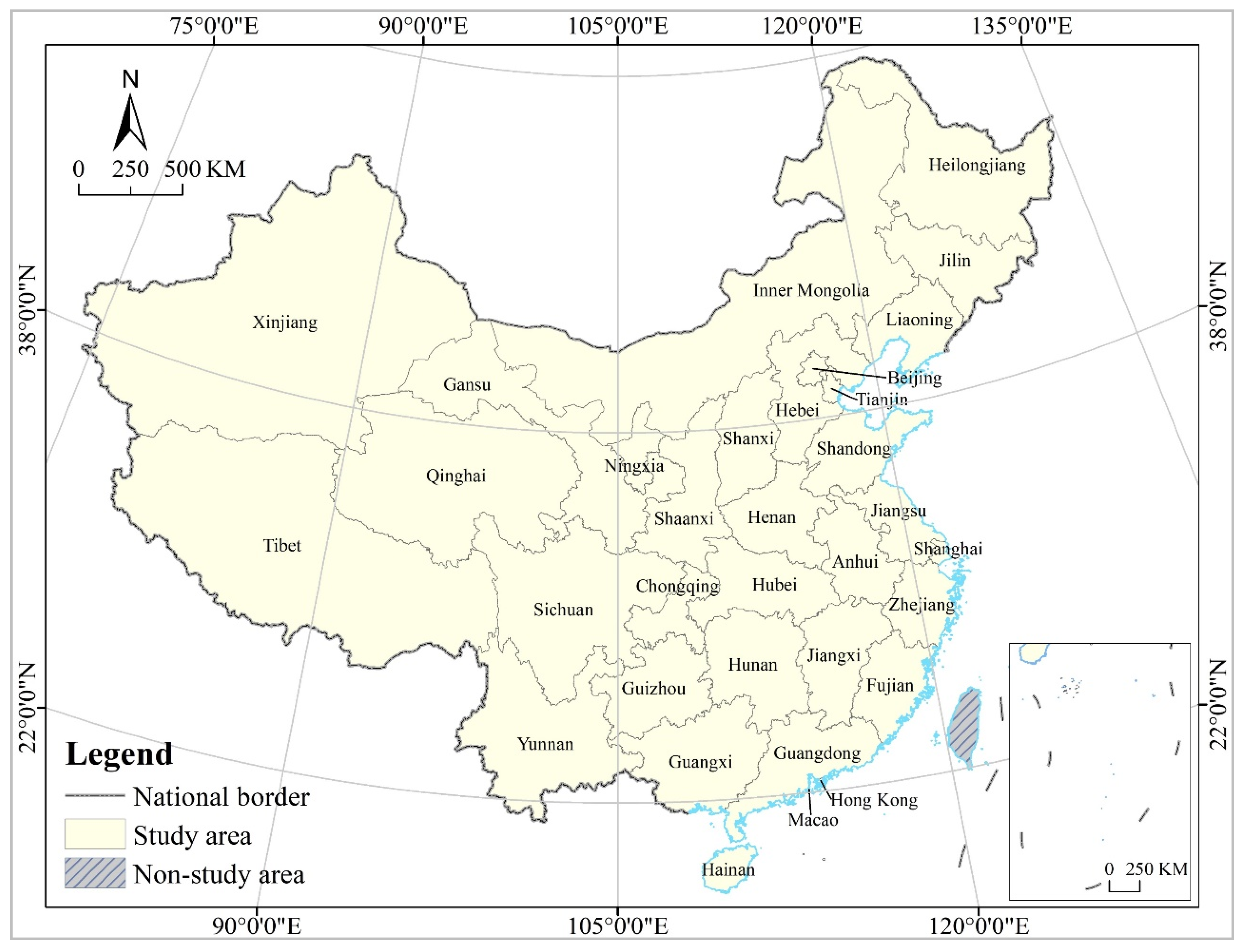
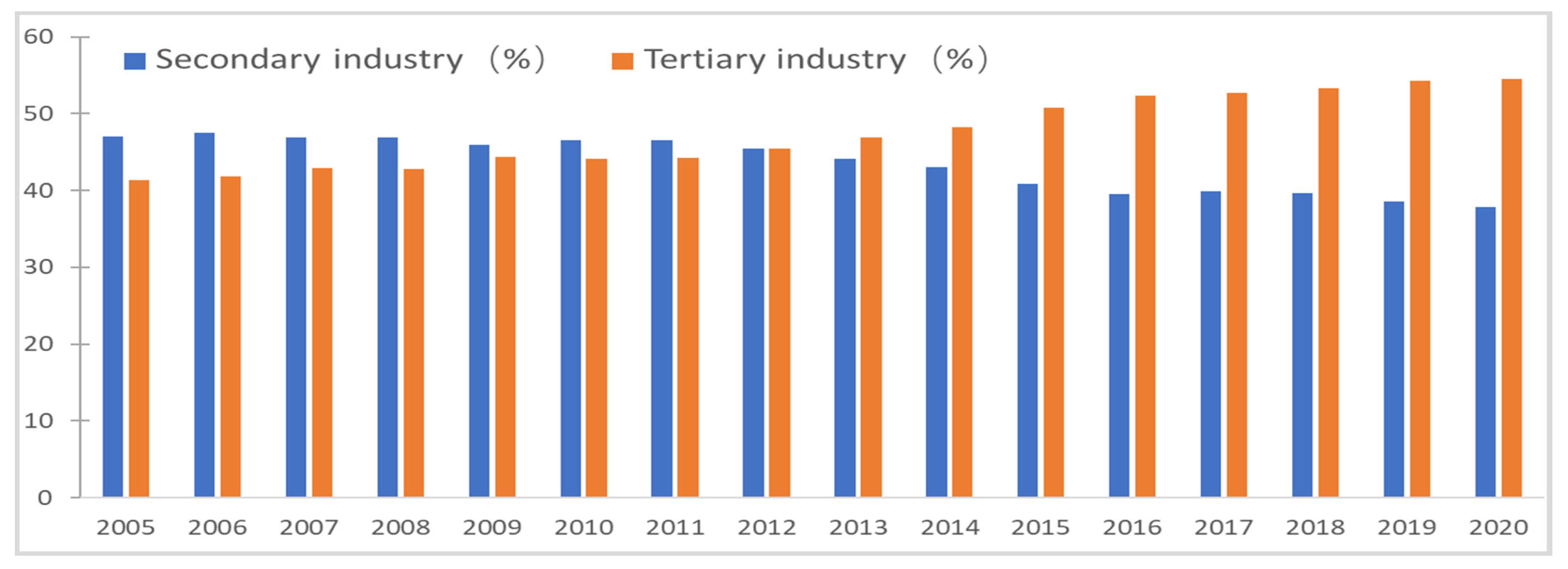


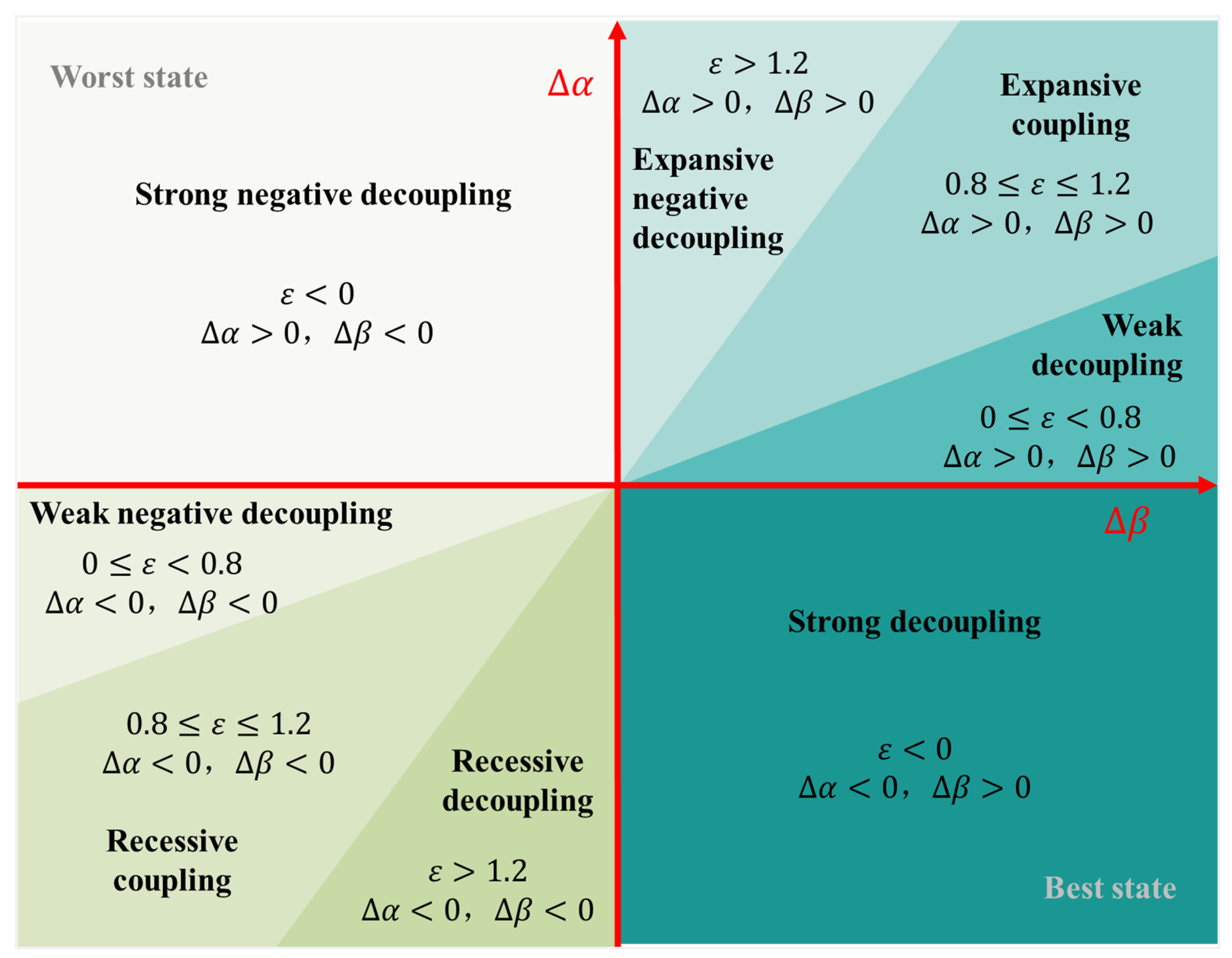
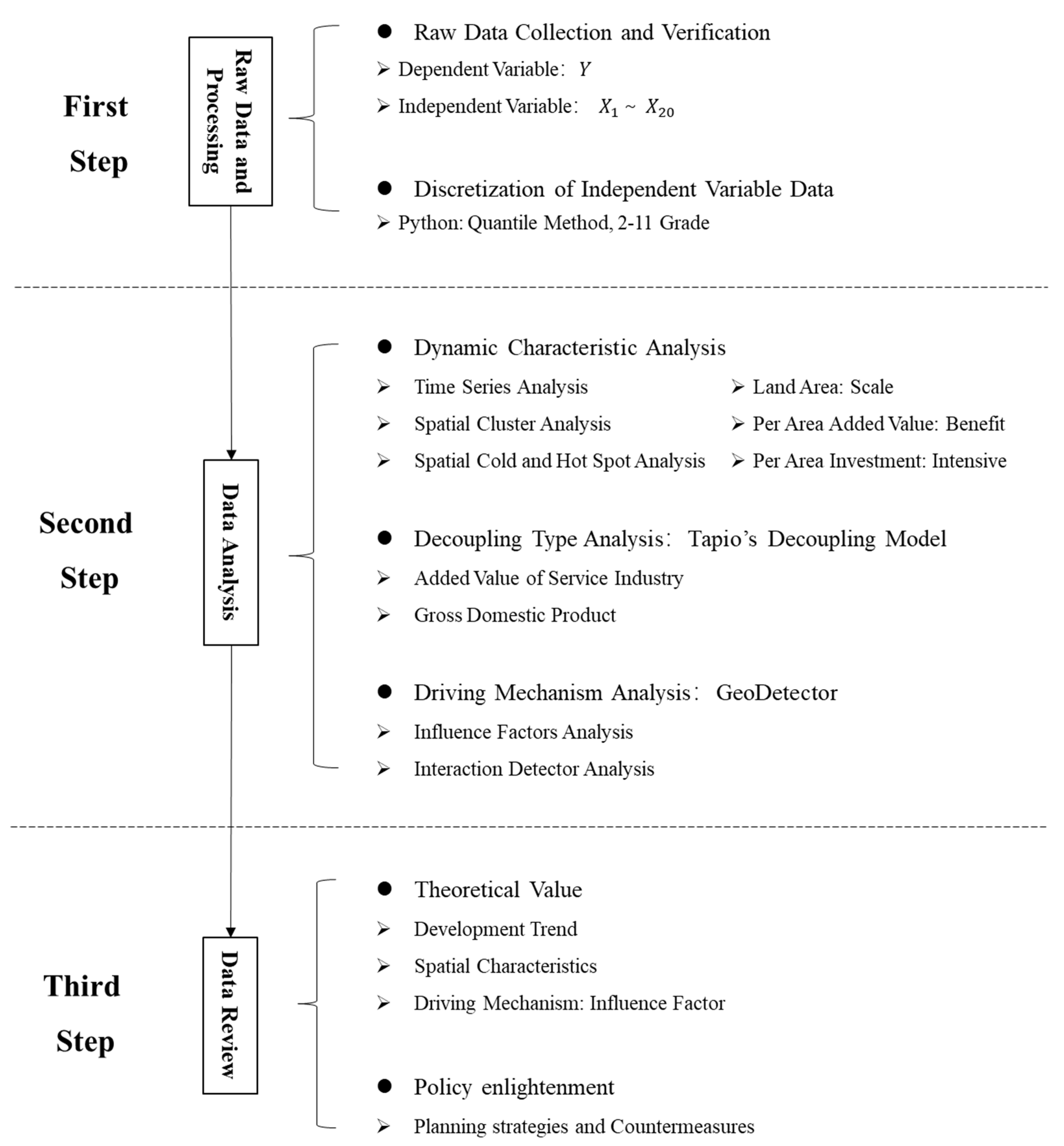




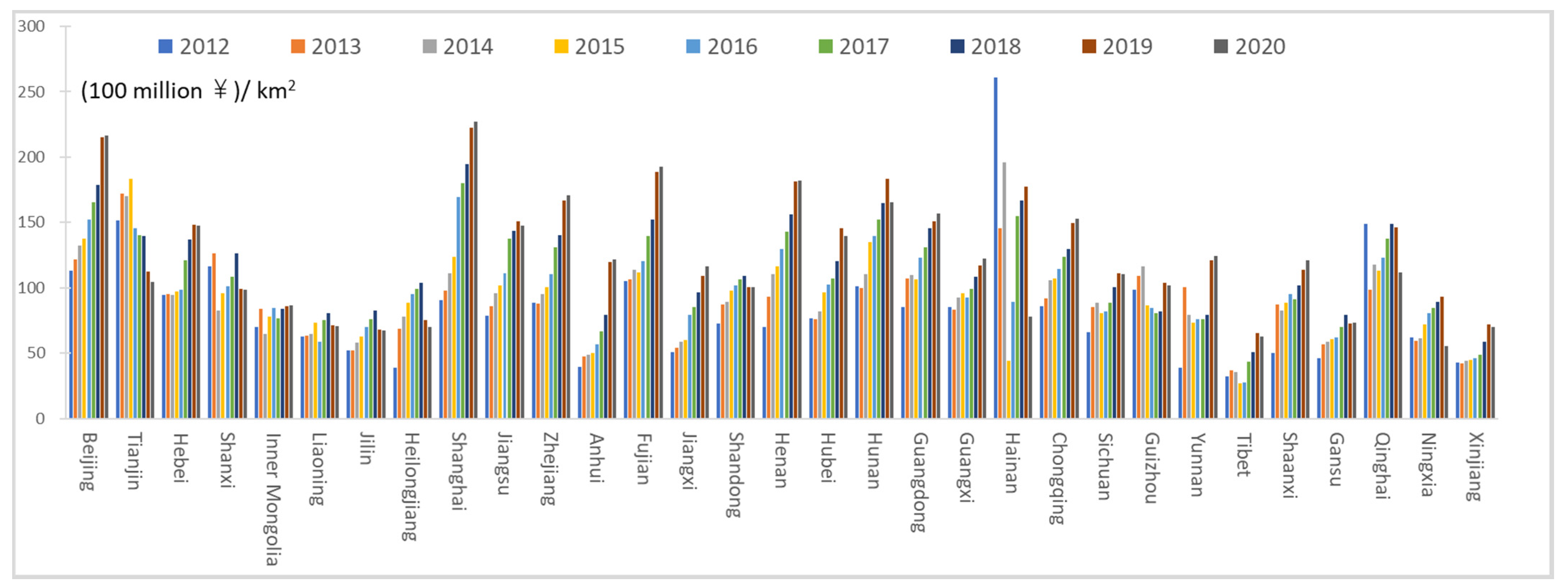


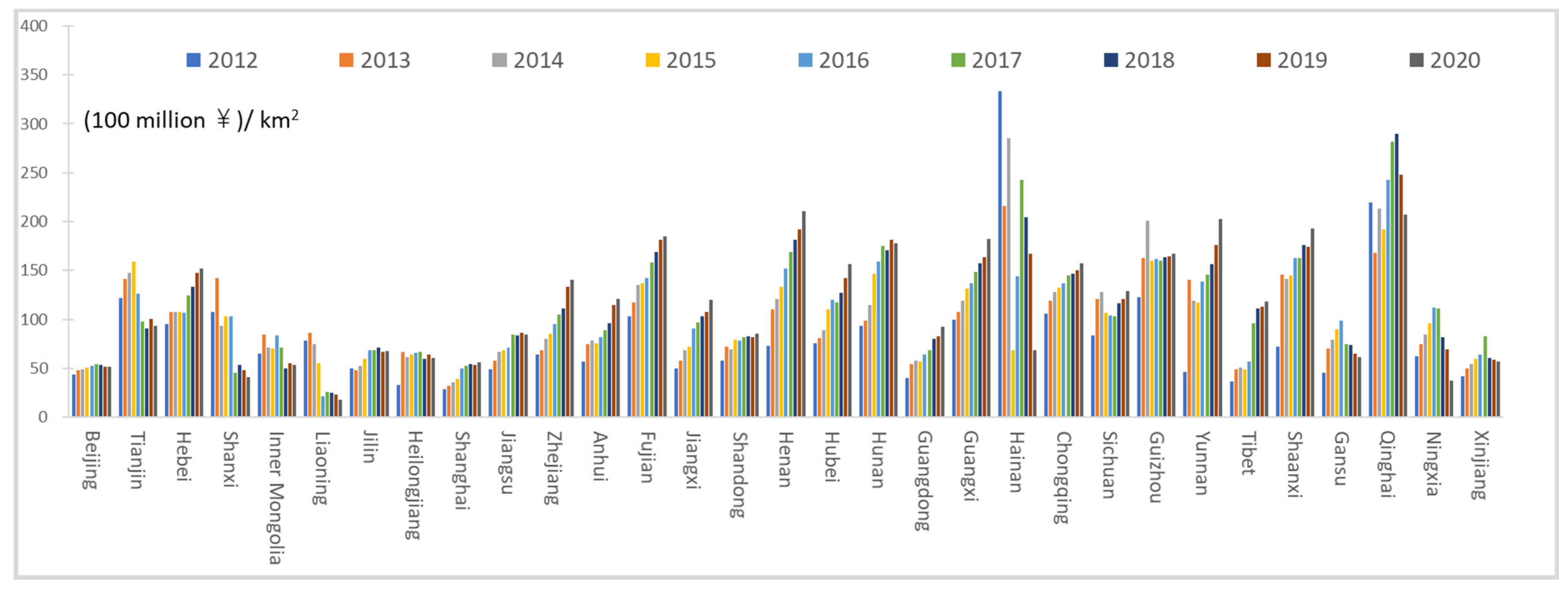



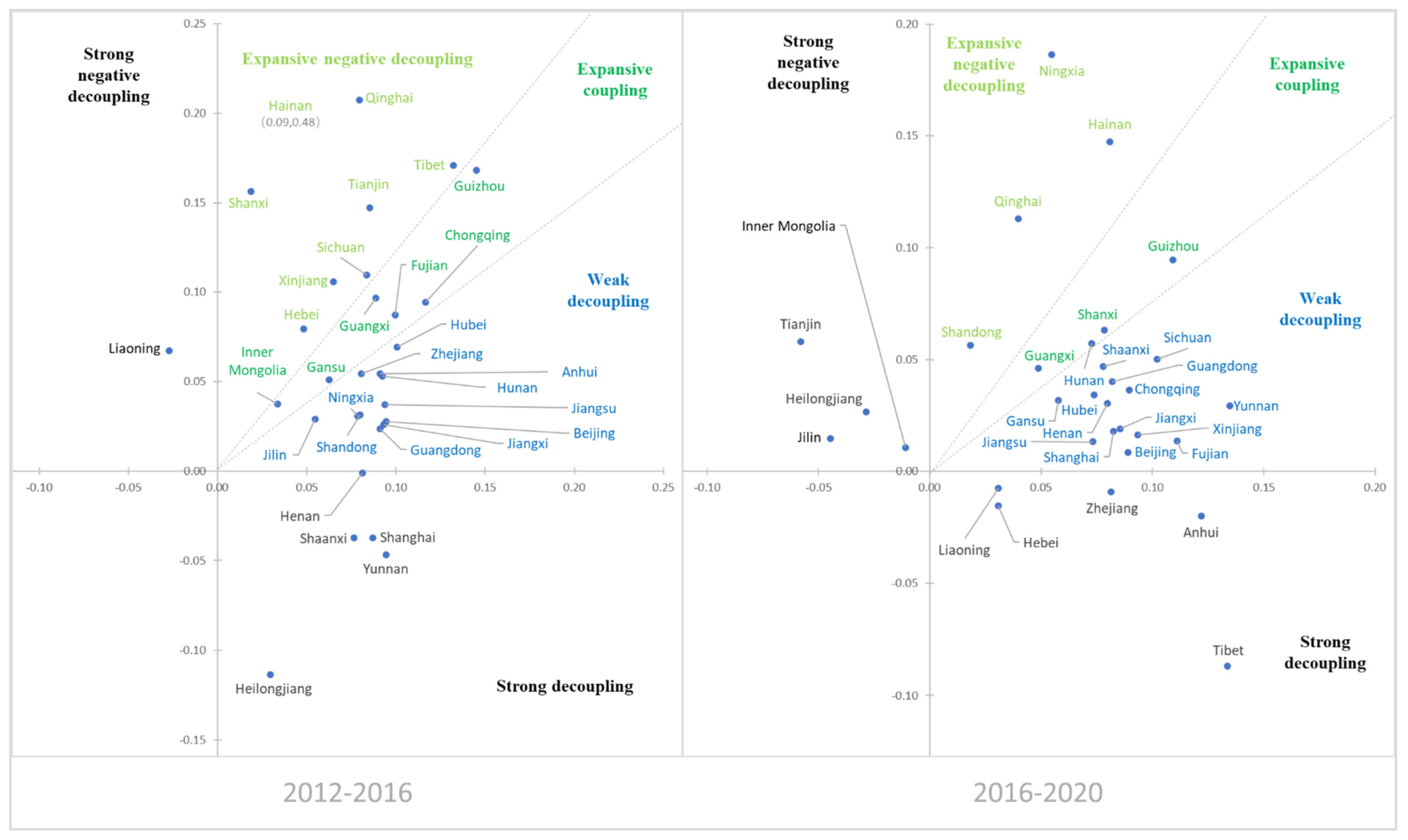
| Graphical Representation | Description | Interaction |
|---|---|---|
 | q(∩) < Min(q(), q()) | Weaken, nonlinear |
 | Min(q(),q()) < q(∩)<Max(q()), q()) | Weaken, uni- |
 | q(∩) > Max(q(), q()) | Enhance, bi- |
 | q(∩) = q() + q() | Independent |
 | q(∩) > q() + q() | Enhance, nonlinear |
 Min(q(, q()
Min(q(, q()  Max(q(), q())
Max(q(), q())  q() + q()
q() + q()  q( ∩).
q( ∩).| Variable | Index | Code | Type |
|---|---|---|---|
| Urban Service-Land Area | - | ||
| Population Urbanization Rate | Urbanization | ||
| Number of People Over 65 | |||
| Per Capita Disposable Income of Residents | |||
| Per Capita Consumption Expenditure of Residents | |||
| Added Value of Secondary Industry | Industrialization | ||
| Per Capita GDP | |||
| Urban Industry Land Area | |||
| Number of Patents Authorized | |||
| Foreign Direct Investment | Globalization | ||
| Export International Trade | |||
| Import International Trade | |||
| Number of Mobile Internet Users | Informatization | ||
| Mobile Internet Data Traffic | |||
| Number of Enterprises with E-Business Transactions | |||
| E-Commerce Sales Amount | |||
| E-Commerce Purchase Amount | |||
| Gross Domestic Product | Scale-Effect | ||
| Total Retail Sales of Social Consumer Goods | |||
| Urban Construction-Land Area | |||
| Resident Population |
| 2012 | 2016 | 2020 | ||||
|---|---|---|---|---|---|---|
| q | p | q | p | q | p | |
| 0.1396 | 0.0605 | 0.3314 | 0.0702 | 0.1234 | 0.0760 | |
| 0.6721 | 0.000 | 0.7014 | 0.000 | 0.7452 | 0.000 | |
| 0.3073 | 0.0181 | 0.2930 | 0.0222 | 0.6153 | 0.0139 | |
| 0.1612 | 0.0447 | 0.2852 | 0.0246 | 0.2802 | 0.0264 | |
| 0.8802 | 0.000 | 0.8704 | 0.000 | 0.8518 | 0.000 | |
| 0.8292 | 0.000 | 0.2343 | 0.0486 | 0.3069 | 0.0489 | |
| 0.8714 | 0.000 | 0.8686 | 0.000 | 0.8720 | 0.000 | |
| 0.2812 | 0.0261 | 0.7450 | 0.000 | 0.8712 | 0.000 | |
| 0.8399 | 0.000 | 0.6146 | 0.000 | 0.5980 | 0.0177 | |
| 0.8420 | 0.000 | 0.7302 | 0.000 | 0.6973 | 0.000 | |
| 0.7860 | 0.000 | 0.6941 | 0.0090 | 0.6120 | 0.0053 | |
| 0.7310 | 0.0039 | 0.8007 | 0.000 | 0.7859 | 0.000 | |
| 0.7314 | 0.000 | 0.7682 | 0.000 | 0.7261 | 0.000 | |
| 0.8532 | 0.000 | 0.8689 | 0.000 | 0.8518 | 0.000 | |
| 0.8788 | 0.000 | 0.6063 | 0.000 | 0.6229 | 0.0042 | |
| 0.8681 | 0.000 | 0.6676 | 0.0122 | 0.6865 | 0.0141 | |
| 0.8311 | 0.000 | 0.9249 | 0.000 | 0.8624 | 0.000 | |
| 0.8462 | 0.000 | 0.9036 | 0.000 | 0.8572 | 0.000 | |
| 0.8542 | 0.000 | 0.8970 | 0.000 | 0.8896 | 0.000 | |
| 0.7680 | 0.000 | 0.7632 | 0.000 | 0.7673 | 0.000 | |
| 2012 | 2016 | 2020 | |
|---|---|---|---|
| Urbanization | 0.3200 | 0.4027 | 0.4410 |
| Industrialization | 0.7155 | 0.6796 | 0.7255 |
| Globalization | 0.8226 | 0.6796 | 0.6358 |
| Informatization | 0.8125 | 0.7423 | 0.7346 |
| Scale-Effect | 0.8249 | 0.8722 | 0.8441 |
Publisher’s Note: MDPI stays neutral with regard to jurisdictional claims in published maps and institutional affiliations. |
© 2021 by the authors. Licensee MDPI, Basel, Switzerland. This article is an open access article distributed under the terms and conditions of the Creative Commons Attribution (CC BY) license (https://creativecommons.org/licenses/by/4.0/).
Share and Cite
Zhao, S.; Zhao, K.; Yan, Y.; Zhu, K.; Guan, C. Spatio-Temporal Evolution Characteristics and Influencing Factors of Urban Service-Industry Land in China. Land 2022, 11, 13. https://doi.org/10.3390/land11010013
Zhao S, Zhao K, Yan Y, Zhu K, Guan C. Spatio-Temporal Evolution Characteristics and Influencing Factors of Urban Service-Industry Land in China. Land. 2022; 11(1):13. https://doi.org/10.3390/land11010013
Chicago/Turabian StyleZhao, Sidong, Kaixu Zhao, Yiran Yan, Kai Zhu, and Chiming Guan. 2022. "Spatio-Temporal Evolution Characteristics and Influencing Factors of Urban Service-Industry Land in China" Land 11, no. 1: 13. https://doi.org/10.3390/land11010013









